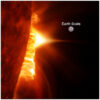A planet swings in front of its star, dimming the starlight we see. Events like these, called transits, provide us with bounties of information about exoplanets—planets around stars other than the sun. But predicting when these special events occur can be challenging…unless you have help from volunteers.
Luckily, a collaboration of multiple teams of amateur planet-chasers, led by researcher Federico R. Noguer from Arizona State University and researchers from NASA’s Jet Propulsion Laboratory (JPL) and Goddard Space Flight Center (GSFC), has taken up the challenge. This collaboration has published the most precise physical and orbital parameters to date for an important exoplanet called WASP-77 A b. These precise parameters help predict future transit events and are crucial for planning spacecraft observations and accurate atmospheric modeling.
The research is published in the journal Publications of the Astronomical Society of the Pacific.
“As a retired dentist and now citizen scientist for Exoplanet Watch, research opportunities like this give me a way to learn and contribute to this amazingly exciting field of astrophysics,” said Anthony Norris, a citizen scientist working on the Exoplanet Watch project.
The study combined amateur astronomy/citizen science data from the Exoplanet Watch and ExoClock projects, as well as the Exoplanet Transit Database. It also incorporated data from NASA’s Spitzer Space Telescope, the Hubble Space Telescope (HST), the James Webb Space Telescope (JWST), and La Silla Observatory.
Exoplanet Watch invites volunteers to participate in exoplanet research, using their own telescopes to observe exoplanets or by analyzing data others have gathered. Another recent article details how the Exoplanet Watch team helped validate a new exoplanet candidate.
WASP-77 A b is a gas giant exoplanet that orbits a sun-like star. It’s only about 20% larger than Jupiter. But that’s where the similarities to our solar system end. This blazing hot gas ball orbits right next to its star—more than 200 times closer to its star than our Jupiter.
More information:
Federico R. Noguer et al, Enhancing Exoplanet Ephemerides by Leveraging Professional and Citizen Science Data: A Test Case with WASP-77 A b, Publications of the Astronomical Society of the Pacific (2024). DOI: 10.1088/1538-3873/ad57f5
Want a piece of the action? Join the Exoplanet Watch project and help contribute to cutting-edge exoplanet science. Anyone can participate–participation does not require citizenship in any particular country.
Citation:
Citizen science collaboration yields precise data on exoplanet WASP-77 A b (2024, September 20)



